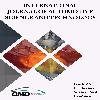Analysis of Combustion and Cycle to Cycle Variations of an Ethanol (E100) Fueled Spark-Ignition Engine
Ethanol, produced from biomass, is a renewable fuel that can be an attractive alternative fuel to gasoline for the increasing concerns of energy security and the environment. In the present work, combustion characteristics of ethanol (E100) fueled spark-ignition engine are compared with base gasoline fuel, and consecutively evaluated the cycle-to-cycle variations (CCV) of the engine parameters using statistical analysis. These investigations were performed on a 250cc air-cooled four-stroke single-cylinder port-fuel injection spark-ignition fueled with ethanol and gasoline fuels. The engine was operated at 3500 rpm and 4000 rpm of engine speed while maintaining the same loads for ethanol and gasoline. It was found from the results that the peak in-cylinder pressure (Ppeak) is lower with ethanol than gasoline at a given load. The Ppeak decreased from 27.5 to 25.5 bar when ethanol was used in the engine at 9.8:1 compression ratio, 3500 rpm, and 5 Nm load. Moreover, the mass fraction burned of the air-fuel mixture was faster for ethanol as compared to gasoline. The CCV with Ppeak, location of Ppeak, engine speed, and indicated mean effective pressure (IMEP) were evaluated. The result showed that CCV of Ppeak and its location were lowered for ethanol related to gasoline. A decrement in the coefficient of variation (COV) of Ppeak and its location from 11.6% to 8.3% and 12.6% to 11.7%, respectively, were observed when ethanol was utilized in the engine instead of gasoline at 3500 rpm and 5 Nm load. This resulted in a decrease in the COV of IMEP and engine speed by 2.8% and 0.25%, respectively, for ethanol as compared to gasoline at 3500 rpm and 5 Nm. This study results indicate the combustion stability of spark ignition engine with ethanol (E100) is better than gasoline fuel.
Keywords:
Combustion analysis, Cycle-to-cycle variations, Port fuel injection, Port fuel injection, Spark-Ignition Engine Ethanol, Gasoline,
___
- S. Phuangwongtrakul S, W. Wechsatol W, T. Sethaput T, K. Suktanga K, Wongwisesa S. Experimental study on sparking ignition engine performance for optimal mixing ratio of ethanol–gasoline blended fuels. Applied Thermal Engineering. 2016; 100: 869-879.
- Heywood JB, Internal Combustion Engine Fundamentals, New Delhi: Tata McGraw-Hill, 2012.
- Gupta SK, Mittal M. Effect of Compression Ratio on the Performance and Emission Characteristics, and Cycle-to-Cycle Combustion Variations of a Spark-Ignition Engine Fueled with Bio-Methane Surrogate. Applied Thermal Engineering, 2019; 148 :1440-1453.
- Glaude PA, Fournet R, Bounaceur R, Molière M. Adiabatic flame temperature from biofuels and fossil fuels and derived effect on NOx emissions. Fuel Processing Technology. 2010; 91(2): 229-235.
- Del Pecchia M, Pessina V, Berni F, d'Adamo A, Fontanesi S. Gasoline-ethanol blend formulation to mimic laminar flame speed and auto-ignition quality in automotive engines. Fuel. 2020; 264: 116741, 2020.
- Gupta SK, Mittal M. Analysis of Cycle-To-Cycle Combustion Variations in a Spark-Ignition Engine Operating under Various Biogas Compositions. Energy & Fuels, 2019; 33(12): 12421–12430.
- Ceviz MA, Yüksel F, Effects of ethanol–unleaded gasoline blends on cyclic variability and emissions in an SI engine, Appl Therm Eng, 2005; 25(5-6): 917-925.
- Wang Y, Luo M, El-Faroug M. The influence of hydrous ethanol gasoline on cycle-to-cycle variation of a spark ignition engine,» Thermal Science, cilt 22, no. 3, pp. 1373-1384, 2018.
- M. Mittal M, G. Zhu G, Schock H. Fast mass-fraction-burned calculation using the net pressure method for real-time applications. Proceedings of the Institution of Mechanical Engineers, Part D: Journal of Automobile Engineering. 2009; 223(3): 389-394.
- Yayın Aralığı: Yılda 4 Sayı
- Başlangıç: 2016
- Yayıncı: Otomotiv Mühendisleri Derneği
Sayıdaki Diğer Makaleler
Naba Kumar Mondal, Soumya Kundu, Kamalesh Sen
Akshey Marwaha, K.A. Subramanian
Shreemohan SİNHA, Anilkumar Shere, K A Subramanian
K. A. Subramanian, Sachin Kumar Gupta
Hüseyin Bayrakçeken, Hicri Yavuz
K. A. Subramanian, Nidhi Chaudhary
K. A. Subramanian, Nidhi Chaudhary
Hakan Serhad Soyhan, Mehrez Gassoumi, Fakher Hamdi, Zouhaier Bouta, Ridha Ennetta
